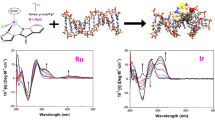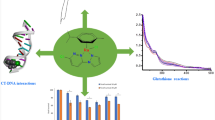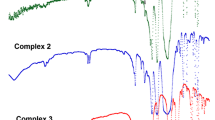Abstract
Triapine (3-AP), is an iron-binding ligand and anticancer drug that is an inhibitor of human ribonucleotide reductase (RNR). Inhibition of RNR by 3-AP results in the depletion of dNTP precursors of DNA, thereby selectively starving fast-replicating cancer cells of nucleotides for survival. The redox-active form of 3-AP directly responsible for inhibition of RNR is the Fe(II)(3-AP)2 complex. In this work, we synthesize 12 analogs of 3-AP, test their inhibition of RNR in vitro, and study the electronic properties of their iron complexes. The reduction and oxidation events of 3-AP iron complexes that are crucial for the inhibition of RNR are modeled with solution studies. We monitor the pH necessary to induce reduction in iron complexes of 3-AP analogs in a reducing environment, as well as the kinetics of oxidation in an oxidizing environment. The oxidation state of the complex is monitored using UV–Vis spectroscopy. Isoquinoline analogs of 3-AP favor the maintenance of the biologically active reduced complex and possess oxidation kinetics that allow redox cycling, consistent with their effective inhibition of RNR seen in our in vitro experiments. In contrast, methylation on the thiosemicarbazone secondary amine moiety of 3-AP produces analogs that form iron complexes with much higher redox potentials, that do not redox cycle, and are inactive against RNR in vitro.
Graphic abstract
The catalytic subunit of human Ribonucleotide Reductase (RNR), contains a tyrosyl radical in the enzyme active site. Fe(II) complexes of 3-AP and its analogs can quench the radical and, subsequently, inactivate RNR. The potency of RNR inhibitors is highly dependent on the redox properties of the iron complexes, which can be tuned by ligand modifications. Complexes are found to be active within a narrow redox window imposed by the cellular environment.











Similar content being viewed by others
References
Graf N, Lippard SJ (2012) Redox activation of metal-based prodrugs as a strategy for drug delivery. Adv Drug Deliv Rev 64:993–1004. https://doi.org/10.1016/j.addr.2012.01.007
Reisner E, Arion VB, Keppler BK, Pombeiro AJL (2008) Electron-transfer activated metal-based anticancer drugs. Inorg Chim Acta 361:1569–1583. https://doi.org/10.1016/j.ica.2006.12.005
Bruijnincx PC, Sadler PJ (2008) New trends for metal complexes with anticancer activity. Curr Opin Chem Biol 12:197–206. https://doi.org/10.1016/j.cbpa.2007.11.013
Alderden RA, Hall MD, Hambley TW (2009) The discovery and development of cisplatin. J Chem Educ 83:728. https://doi.org/10.1021/ed083p728
Clarke MJ (2002) Ruthenium metallopharmaceuticals. Coord Chem Rev 232:69–93. https://doi.org/10.1016/S0010-8545(02)00025-5
Galanski M, Arion V, Jakupec M, Keppler B (2003) Recent developments in the field of tumor-inhibiting metal complexes. Curr Pharm Des 9:2078–2089. https://doi.org/10.2174/1381612033454180
Liu M-C, Lin T-S, Cory JG et al (1996) Synthesis and biological activity of 3- and 5-amino derivatives of pyridine-2-carboxaldehyde thiosemicarbazone. J Med Chem 39:2586–2593. https://doi.org/10.1021/jm9600454
Cory JG, Cory AH, Rappa G et al (1995) Structure-function relationships for a new series of pyridine-2-carboxaldehyde thiosemicarbazones on ribonucleotide reductase activity and tumor cell growth in culture and in vivo. Adv Enzyme Regul 35:55–68. https://doi.org/10.1016/0065-2571(94)00005-N
Finch RA, Liu M-C, Cory AH et al (1999) Triapine (3-aminopyridine-2-carboxaldehyde thiosemicarbazone; 3-AP): an inhibitor of ribonucleotide reductase with antineoplastic activity. Adv Enzyme Regul 39:3–12. https://doi.org/10.1016/S0065-2571(98)00017-X
Dai L, Lin Z, Qiao J et al (2017) Ribonucleotide reductase represents a novel therapeutic target in primary effusion lymphoma. Oncogene 36:5068–5074. https://doi.org/10.1038/onc.2017.122
Cory JG, Cory AH, Rappa G et al (1994) Inhibitors of ribonucleotide reductase. Biochem Pharmacol 48:335–344. https://doi.org/10.1016/0006-2952(94)90105-8
Finch RA, Liu MC, Grill SP et al (2000) Triapine (3-aminopyridine-2-carboxaldehyde-thiosemicarbazone): a potent inhibitor of ribonucleotide reductase activity with broad spectrum antitumor activity. Biochem Pharmacol 59:983–991. https://doi.org/10.1016/S0006-2952(99)00419-0
Nutting CM, Van Herpen CML, Miah AB et al (2009) Phase II study of 3-AP triapine in patients with recurrent or metastatic head and neck squamous cell carcinoma. Ann Oncol 20:1275–1279. https://doi.org/10.1093/annonc/mdn775
Traynor AM, Lee J-W, Bayer GK et al (2010) A phase II trial of triapine (NSC# 663249) and gemcitabine as second line treatment of advanced non-small cell lung cancer: Eastern Cooperative Oncology Group Study 1503. Invest New Drugs 28:91–97. https://doi.org/10.1007/s10637-009-9230-z
Le TM, Poddar S, Capri JR et al (2017) ATR inhibition facilitates targeting of leukemia dependence on convergent nucleotide biosynthetic pathways. Nat Commun. https://doi.org/10.1038/s41467-017-00221-3
Aye Y, Long MJC, Stubbe J (2012) Mechanistic studies of semicarbazone triapine targeting human ribonucleotide reductase in vitro and in mammalian cells: tyrosyl radical quenching not involving reactive oxygen species. J Biol Chem 287:35768–35778. https://doi.org/10.1074/jbc.M112.396911
Mathews CK (2016) The most interesting enzyme in the world. Structure 24:843–844. https://doi.org/10.1016/j.str.2016.05.006
Uhlin U, Eklund H (1994) Structure of ribonucleotide reductase protein R1. Nature 370:533–539. https://doi.org/10.1038/370533a0
Nordlund P, Reichard P (2006) Ribonucleotide reductases. Annu Rev Biochem 75:681–706. https://doi.org/10.1146/annurev.biochem.75.103004.142443
Aird KM, Zhang R (2015) Nucleotide metabolism, oncogene-induced senescence and cancer. Cancer Lett 356:204–210
Richardson DR, Kalinowski DS, Richardson V et al (2009) 2-acetylpyridine thiosemicarbazones are potent iron chelators and antiproliferative agents: redox activity, iron complexation and characterization of their antitumor activity. J Med Chem 52:1459–1470. https://doi.org/10.1021/jm801585u
Enyedy ÉA, Nagy NV, Zsigó É et al (2010) Comparative solution equilibrium study of the interactions of copper(II), iron(II) and zinc(II) with triapine (3-aminopyridine-2-carbaldehyde thiosemicarbazone) and related ligands. Eur J Inorg Chem 2010:1717–1728. https://doi.org/10.1002/ejic.200901174
Enyedy É, Primik MF, Kowol CR et al (2011) Interaction of triapine and related thiosemicarbazones with iron(III)/(II) and gallium(III): a comparative solution equilibrium study. Dalton Trans 40:5895–5905. https://doi.org/10.1039/c0dt01835j
Kowol CR, Trondl R, Heffeter P et al (2009) Impact of metal coordination on cytotoxicity of 3-aminopyridine-2-carboxaldehyde thiosemicarbazone (Triapine) and novel insights into terminal dimethylation. J Med Chem 52:5032–5043. https://doi.org/10.1021/jm900528d
Pelosi G (2010) Thiosemicarbazone metal complexes: from structure to activity. Open Crystallogr J 3:16–28. https://doi.org/10.2174/1874846501003020016
Antholine WE, Knight JM, Petering DH (1976) Inhibition of tumor cell transplantability by iron and copper complexes of 5-substituted 2-formylpyridine thiosemicarbazones. J Med Chem 19:339–341. https://doi.org/10.1021/jm00224a030
Wallace R, Richard Thomson J, Bell MJ, Skipper HE (1956) Observations on the antileukemic activity of pyridine-2-carboxaldehyde thiosemicarbazone and thiocarbohydrazone. Cancer Res 16:167–170
Agrawal KC, Sartorelli AC (1969) Potential antitumor agents. II. Effects of modifications in the side chain of 1-formylisoquinoline thiosemicarbazone. J Med Chem 12:771–774. https://doi.org/10.1021/jm00305a011
French FA, Blanz EJ (1965) The carcinostatic activity of α-N heterocyclic carboxaldehyde thiosemicarbazones. Cancer Res 25:1454–1458
Popović-Bijelić A, Kowol CR, Lind MES et al (2011) Ribonucleotide reductase inhibition by metal complexes of Triapine (3-aminopyridine-2-carboxaldehyde thiosemicarbazone): a combined experimental and theoretical study. J Inorg Biochem 105:1422–1431. https://doi.org/10.1016/j.jinorgbio.2011.07.003
Mooney PD, Booth BA, Moore EC et al (1974) Potential antitumor agents. Synthesis and biochemical properties of 5-N-alkylamino-, N,N-dialkylamino-, and N-alkylacetamido-1-formylisoquinoline thiosemicarbazones. J Med Chem 17:1145–1150. https://doi.org/10.1021/jm00257a004
Lin ZP, Belcourt MF, Carbone R et al (2007) Excess ribonucleotide reductase R2 subunits coordinate the S phase checkpoint to facilitate DNA damage repair and recovery from replication stress. Biochem Pharmacol 73:760–772. https://doi.org/10.1016/j.bcp.2006.11.014
Buss Joan L, Greene Bryan T, Turner JoLyn et al (2005) Iron chelators in cancer chemotherapy. Curr Top Med Chem 4:1623–1635. https://doi.org/10.2174/1568026043387269
Yu Y, Wong J, Lovejoy DB et al (2006) Chelators at the cancer coalface: desferrioxamine to triapine and beyond. Clin Cancer Res 12:6876–6883. https://doi.org/10.1158/1078-0432.CCR-06-1954
Kappus H (1986) Overview of enzyme systems involved in bioreduction of drugs and in redox cycling. Biochem Pharmacol 35:1–6. https://doi.org/10.1016/0006-2952(86)90544-7
Popović-Bijelić A, Kowol CR, Lind MES et al (2011) Ribonucleotide reductase inhibition by metal complexes of triapine (3-aminopyridine-2-carboxaldehyde thiosemicarbazone): a combined experimental and theoretical study. J Inorg Biochem 105:1422–1431. https://doi.org/10.1016/j.jinorgbio.2011.07.003
Bernhardt PV, Sharpe PC, Islam M et al (2009) Iron chelators of the dipyridylketone thiosemicarbazone class: precomplexation and transmetalation effects on anticancer activity. J Med Chem 52:407–415. https://doi.org/10.1021/jm801012z
Kolesar JM, Schelman WR, Geiger PG et al (2008) Electron paramagnetic resonance study of peripheral blood mononuclear cells from patients with refractory solid tumors treated with Triapine. J Inorg Biochem 102:693–698. https://doi.org/10.1016/j.jinorgbio.2007.10.013
Pelivan K, Miklos W, Van Schoonhoven S et al (2016) Differences in protein binding and excretion of triapine and its Fe(III) complex. J Inorg Biochem 160:61–69. https://doi.org/10.1016/j.jinorgbio.2015.10.006
Acknowledgements
Special thanks to Jon Brosmer for helpful discussions.
Author information
Authors and Affiliations
Corresponding author
Additional information
Publisher's Note
Springer Nature remains neutral with regard to jurisdictional claims in published maps and institutional affiliations.
Electronic supplementary material
Below is the link to the electronic supplementary material.
775_2019_1675_MOESM1_ESM.pdf
Supplementary material 1 The following files are available free of charge. Complete Fe(II) titrations, pH titrations, oxidation spectra, and cyclic voltammograms of all 3-AP analog complexes (Figures S1–S5); Synthesis procedures for compounds; HPLC traces of 3-AP analogs; 1H-NMR and 13C-NMR spectra (PDF) (PDF 5714 kb)
Rights and permissions
About this article
Cite this article
Plamthottam, S., Sun, D., Van Valkenburgh, J. et al. Activity and electrochemical properties: iron complexes of the anticancer drug triapine and its analogs. J Biol Inorg Chem 24, 621–632 (2019). https://doi.org/10.1007/s00775-019-01675-0
Received:
Accepted:
Published:
Issue Date:
DOI: https://doi.org/10.1007/s00775-019-01675-0




